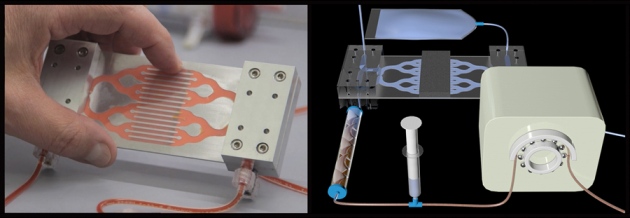博文
人工脾面世或有助于克服血液感染
||
许多人听说过,人工肾、人工心、人工肺和人工肝,人工脾大概没有听说过,不过现在人工脾也有了。受到脾脏功能的启发,美国哈佛大学Wyss生物启发工程研究所Donald E Ingber等最近发明了一种人工脾,能治疗包括埃博拉等感染导致的脓毒症的血液清洗装置。描述这一技术的论文9月14日发表在《自然医学》上。

Blood infections can bevery difficult to treat, and can lead to sepsis, an often-fatal immuneresponse. More than 50% of the time, physicians cannot diagnose the cause of aninfection that has prompted sepsis, and so they resort to antibiotics that attacka broad range of bacteria2.This approach is not always effective, and can lead to antibiotic resistance inbacteria.
In search of a way toclear any infection, a team led by Donald Ingber, a bioengineer at the WyssInstitute for Biologically Inspired Engineering in Boston, Massachusetts,developed an artificial 'biospleen' to filter blood.
The device uses a modifiedversion of mannose-binding lectin (MBL), a protein found in humans that bindsto sugar molecules on the surfaces of more than 90 different bacteria, virusesand fungi, as well as to the toxins released by dead bacteria that trigger theimmune overreaction in sepsis.
The researchers coatedmagnetic nanobeads with MBL. As blood enters the biospleen device, passes bythe MBL-equipped nanobeads, which bind to most pathogens. A magnet on thebiospleen device then pulls the beads and their quarry out of the blood, whichcan then be routed back into the patient.
To test the device, Ingber and his team infected ratswith either E. coli or Staphylococcus aureus and filtered bloodfrom some of the animals through the biospleen. Five hours after infection, 89%of the rats whose blood had been filtered were still alive, compared with only14% of those that were infected but not treated. The researchers found that thedevice had removed more than 90% of the bacteria from the rats' blood. The ratswhose blood had been filtered also had less inflammation in their lungs andother organs, suggesting they would be less prone to sepsis.
The researchers then tested whether the biospleen couldhandle the volume of blood in an average adult human — about 5 litres. They ranhuman blood containing a mixture of bacteria and fungi through the biospleen ata rate of 1 litre per hour, and found that the device removed most of thepathogens within five hours.
That degree of efficacy is probably enough to control aninfection, Ingber says. Once the biospleen has removed most pathogens from theblood, antibiotics and the immune system can fight off remaining traces ofinfection — such as pathogens lodged in the organs, he says.
Ingber says that the biospleen could also help to treatviral diseases such as HIV and Ebola, in which survival depends on lowering theamount of virus in the blood to a negligible level. His group is now testingthe biospleen on pigs.
Nigel Klein, an infection and immunity expert atUniversity College London, says that the biospleen could also allowdiagnosticians to collect samples of a pathogen from the blood and then cultureit to identify it and determine what drugs will best treat it. As bloodtransfusion and filtration are already common practices, he expects that thebiospleen could move into human clinical trials within a couple of years.
Nature doi:10.1038/nature.2014.15917
https://blog.sciencenet.cn/blog-41174-827929.html
上一篇:STAP细胞事件再生枝节
下一篇:人工脾能成为埃博拉的救星吗?